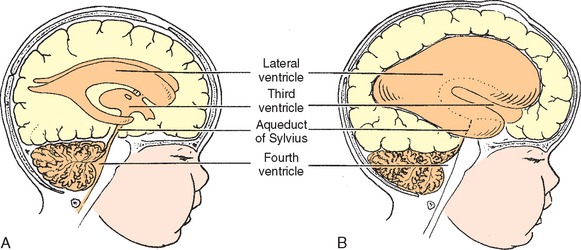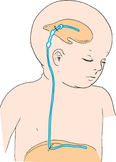Therapeutic Management
Acute bacterial meningitis is a medical emergency that requires early recognition and immediate institution of therapy to prevent death or residual disabilities. The initial therapeutic management includes:
The child is isolated from other children, usually in an intensive care unit for close observation. An IV infusion is started to facilitate the administration of antimicrobial agents, fluids, antiepileptic drugs, and blood, if needed. The child is placed on a cardiac monitor and in respiratory isolation.
Drugs.: Until the causative organism is identified, the choice of antibiotic is based on the known sensitivity of the organism most likely to be the infective agent. After identification of the organism, antimicrobial agents are adjusted accordingly.
Dexamethasone may play a role in the initial management of increased ICP and cerebral herniation, but its ability to reduce long-term complications of bacterial meningitis remains controversial. There is evidence that dexamethasone therapy decreases the risk of neurologic sequelae in children with H. influenzae type b meningitis and should be considered for use in other bacterial types of meningitis (American Academy of Pediatrics, 2006; Prober, 2007). It should not be used if aseptic or nonbacterial meningitis is suspected (Bonthius and Karacay, 2002).
Signs of gastrointestinal hemorrhage or secondary infection may complicate steroid administration. Antibiotic treatment with cephalosporins demonstrates superiority for promptly sterilizing the CSF and reducing the incidence of severe hearing impairment.
Nonspecific Measures.: Maintaining hydration is a prime concern, and IV fluids and the type and amount of fluid are determined by the patient’s condition. The optimum hydration involves correction of any fluid deficits followed by fluid restriction as ordered to prevent cerebral edema. Cerebral edema and electrolyte disturbances are associated with poor neurologic outcome following bacterial meningitis (Bonthius and Karacay, 2002). Children with bacterial meningitis must be monitored for signs of increased ICP. If needed, measures to decrease ICP are implemented (see p. 982).
Complications are treated appropriately, such as aspiration of subdural effusion in infants and treatment for disseminated intravascular coagulation syndrome. Shock is managed by restoration of circulating blood volume and maintenance of electrolyte balance. Seizures can occur during the first few days of treatment. These are controlled with the appropriate antiepileptic drug. Hearing loss is not uncommon. The patient should undergo auditory evaluation 6 months after the illness has resolved.
Lumbar puncture is carried out as needed to determine the effectiveness of therapy. The patient is evaluated neurologically during the convalescent period.
Prognosis.: Ten percent to 15% of cases of bacterial meningitis are fatal (Centers for Disease Control and Prevention, 2000). The child’s age, duration of illness before antibiotic therapy, rapidity of diagnosis after onset, type of organism, and adequacy of therapy are important in the prognosis for bacterial meningitis. Bacterial meningitis can result in brain damage, hearing loss, or learning disability (Centers for Disease Control and Prevention, 2000; Prober, 2007).
Neonatal meningitis carries the highest mortality. However, with the development of new antibiotics and the advent of aggressive supportive care measures, the mortality rate for bacterial meningitis in children caused by H. influenzae type b, S. pneumoniae, and N. meningitidis is less than 10% in most studies (Prober, 2007).
The sequelae of bacterial meningitis are seen most often when the disease occurs in the first 2 months of life and least often in children with meningococcal meningitis. The residual deficits in infants are primarily a result of communicating hydrocephalus and the greater effects of cerebritis on the immature brain. In older children the residual effects are related to the inflammatory process itself or result from vasculitis associated with the disease. Bacterial meningitis continues to cause substantial morbidity in infants and children. The mortality rate and incidence of poor neurologic outcome are highest in patients with pneumococcal meningitis (Saez-Llorens and McCracken, 2003; Prober, 2007).
Hearing impairment is the most common sequela of this disease. Evaluation of cranial nerve VIII is needed for at least a 6-month follow-up period to assess for possible hearing loss.
Prevention.: Vaccines are available for types A, C, Y, and W-135 meningococci and H. influenzae type b. Routine meningococcal polysaccharide vaccination of children is licensed for use only in children 2 years and older (Pichichero, 2005). The new quadrivalent meningococcal conjugate vaccine (Menactra) was licensed by the U.S. Food and Drug Administration (FDA) in January 2005 for children and adults from 11 to 55 years (Pichichero, 2005). However, routine vaccinations for H. influenzae type b are recommended for all children beginning at 2 months of age (see Immunizations, Chapter 12). Pneumococcal conjugate vaccine is now recommended for all children beginning at 2 months of age (American Academy of Pediatrics, 2000a).
Nursing Care Management
The room is kept as quiet as possible, and environmental stimuli are kept to a minimum because most children with meningitis are sensitive to noise, bright lights, and other external stimuli. Most children are more comfortable without a pillow and with the head of the bed slightly elevated. A side-lying position is more often assumed because of nuchal rigidity. The nurse should avoid actions that cause pain or increase discomfort, such as lifting the child’s head. Evaluating the child for pain and implementing appropriate relief measures are important during the initial 24 to 72 hours. Acetaminophen with codeine is often used. Measures are used to ensure safety because the child is often restless and subject to seizures.
The nursing care of the child with meningitis is determined by the child’s symptoms and treatment. Observation of vital signs, neurologic signs, LOC, urinary output, and other pertinent data is carried out at frequent intervals. The child who is unconscious is managed as described previously (see p. 981), and all children are observed carefully for signs of the complications just described, especially increased ICP, shock, or respiratory distress. Frequent assessment of the open fontanels is needed in the infant because subdural effusions and obstructive hydrocephalus can develop as a complication of meningitis.
Fluids and nourishment are determined by the child’s status. The child with dulled sensorium is usually given nothing by mouth. Other children are allowed clear liquids initially and, if these are tolerated, progress to a diet suitable for their age. Careful monitoring and recording of intake and output are needed to determine deviations that might indicate impending shock or increasing fluid accumulation, such as cerebral edema or subdural effusion.
One of the most difficult problems in the nursing care of children with meningitis is maintaining IV infusion for the length of time needed to provide adequate antimicrobial therapy (usually 10 days). Because continuous IV fluids are usually not necessary, an intermittent infusion device is used. In some cases children who are recovering uneventfully are sent home with the device, and the parents are taught IV drug administration.
Family Support.: The sudden nature of the illness makes emotional support of the child and parents extremely important. Parents are upset and concerned about their child’s condition and often feel guilty for not having suspected the seriousness of the illness sooner. They need much reassurance that the natural onset of meningitis is sudden and that they acted responsibly in seeking medical assistance when they did. The nurse encourages the parents to openly discuss their feelings to minimize blame and guilt. They also are kept informed of the child’s progress and of all procedures, results, and treatments. In the event that the child’s condition worsens, they need the same psychologic care as parents who face the possible death of their child (see Chapter 18).


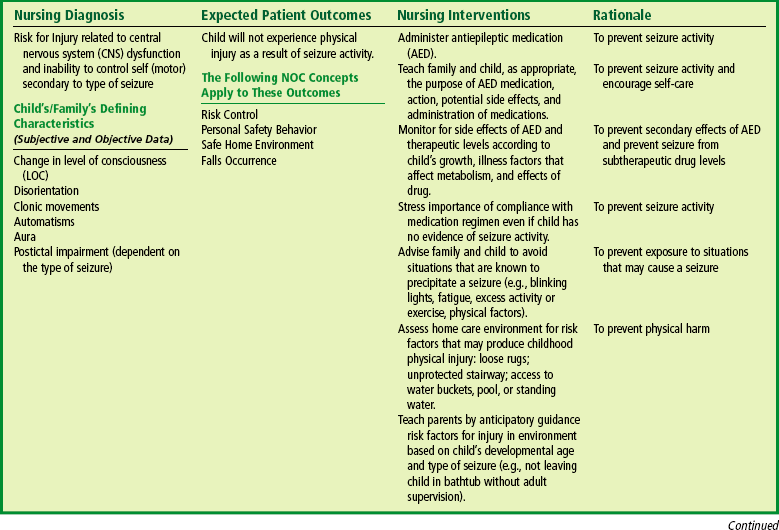
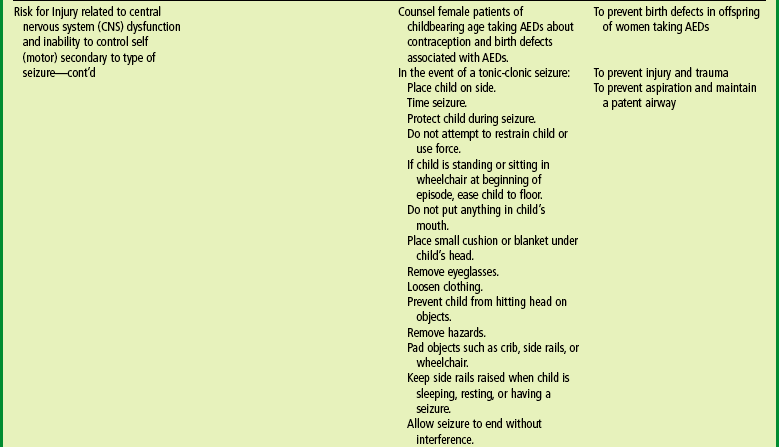
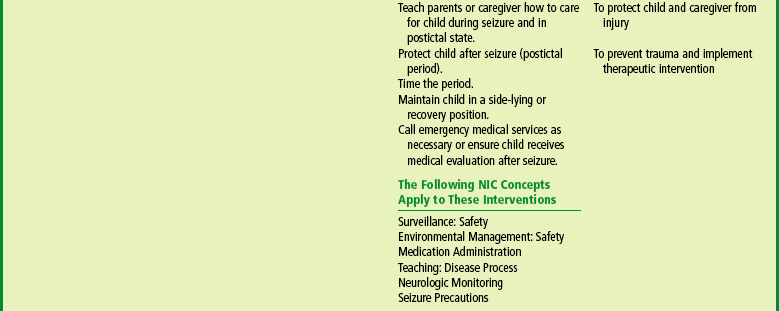


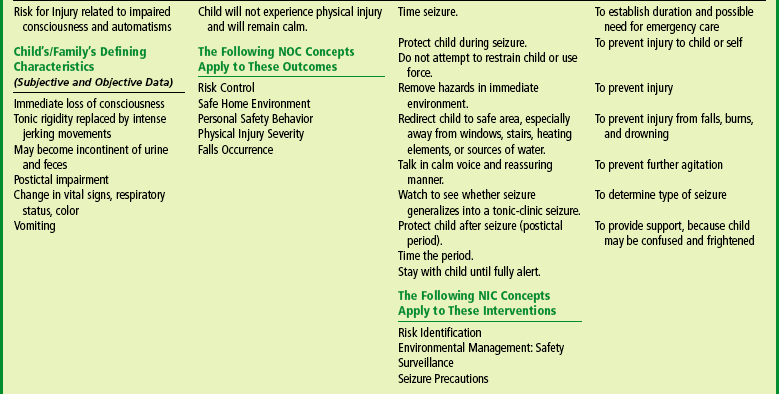

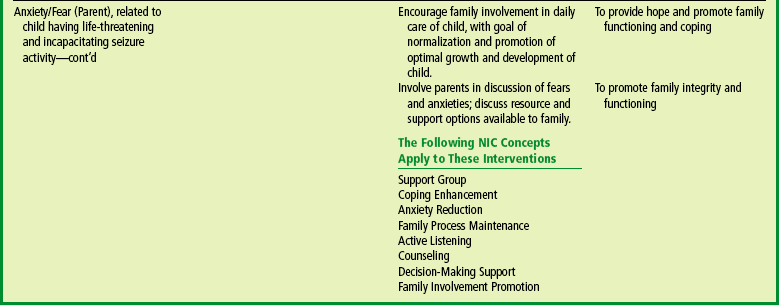
 FAMILY FOCUS
FAMILY FOCUS